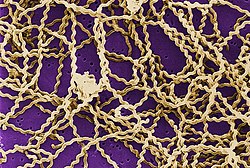Swamp Fever

For the second time in as many years we have seen a patient with Leptospirosis at Tulane Medical Center. This is a fairly rare disease that we are seeing in New Orleans more often that we probably should. Part of the reason is that there are so many gutted house being renovated. People are exposed to rat urine in the process of cleaning these properties. Here is a great review by our own Dr. Herman Toliver and Dr. Kevin Krane on Leptospirosis in New Orleans.
As a reminder, Leptospirosis is caused by a spirochaete bacterium called Leptospira spp. Those at risk include veteriarians, farmers, and those working in abandoned or blighted buildings. The patient just happened to be in New Orleans working on an old house in the french quarter. Signs and symptoms include flu-like symptoms (fever, chills, myalgia), renal failure, liver failure, headache, menigitis and DIC. Here a brief synopsis of the patient’s story.
A pleasant 61-year-old man with no prior medical history, who was evaluated in the ED for bilateral leg pain. Per the patient, the patient report that he recently moved here from California 2 or 3 months ago. He has been working in his home and is an avid runner and has been exercising, but also has been working in his house renovating part of his home. The patient states that he has been in his house without any air conditioner for the last few days and the mean temperature had been in the 80s to 90s. He also reports that he has been running prior to any change of symptoms. The patient reports that 5 days prior to admission, he started feeling bad. He started having some bilateral leg pain which he describes as kind of achy pain. He again has been exercising and also working in his home in the heat. He also has been working in the attic putting new floorboards and paneling. He also reports that he started having fevers and subsequently he started taking aspirin every 6 hours. He had temperatures go up to about 102.8 and after aspirin, temperature has come down to about 99 or so, but once the aspirin was off, temperature would spike up again to above 102. So he continued taking aspirin almost continuously throughout the last 4 or 5 days until presentation. In the emergency room, he was evaluated and found to have an elevated BUN and creatinine. He also reports has been feeling kind of run down, almost having flu like symptoms with some generalized weakness. He also has an elevated CK above 8000 and elevated myoglobin above 20,000. The patient reports that he had not have been having too much urine output for the last 3 days also. So we were consulted for acute kidney injury presumed to be due to rhabdomyolysis. The patient subsequently developed liver failure with a bilirubin > 20.
With supportive care, which included dialysis for several days the patients had a full recovery which included a improvement of her renal and liver failure.
– Adrian Baudy

Recent Comments